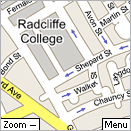Google Local for Mobile: bellwether Java cell phone applet
The new Google Local for Mobile is a compelling little demonstration of what a Java cell phone applet can do. It’s carefully tuned to the constraints of cell phone hardware, uses the network well, and makes good use of the graphic display and local caching.
Google Local for Mobile
The installation process was much easier than I’d expected. Google’s site does a good job helping you figure out whether your phone will actually run their applet, which is nice and presumably reduces customer disappointment. The site directs you to a web page to open on your phone, and offers to SMS you the URL to save you the trouble of typing it in. The resulting web page sniffs your browser to determine which download you need, so you only have to make a few clicks to download and install the applet.
In my case, I had to put up with some very clunky Java applet management UI produced by the local cell phone OS (controlled by my phone manufacturer, not Google). For example, the phone asked me to confirm that I wanted to install a “MIDlet”, whatever the heck that is. I expect most cell phone manufacturers outsource the utility UI like this to the cheapest bidder, with predictably poor results.
The Google Local applet itself is simple but quite polished for a phone app. It feels a lot like Google Maps. The keyboard UI for zooming in and out took some getting used to. You can read a complete description in the Google Local tour. The UI suffers from the fact that the key to zoom in (the OK button, or the center of the directional pad) is otherwise unrelated to the key you press to zoom out (a mappable button that labeled here as "Zoom -"). This is a reasonable trade-off given the small keyset available on a phone, but nonetheless the lack of conceptual connection between the buttons makes it hard to learn their relationship. It’s also confusing to see the zoom out command clearly labeled, when what every user will need to do first is zoom in. The applet does offer a quick tip on how to zoom.
The zoom UI also has the unusual behavior that setting the zoom level doesn’t take effect immediately—you can zoom in or out multiple levels, then wait a second for the new zoom level to kick in. Again, this is a reasonable trade-off given the bandwidth on a phone, but again this is confusing for the new user. Now that I know how zooming works, I think it’s elegant, but I expect a significant number of users will be completely confused and give up on the applet after a few minutes of failing to successfully zoom around.
Other small points: I was disappointed that Google’s address lookup couldn’t find my house. I was also disappointed that Google Local couldn’t show me my approximate location on the map based on info from the cell towers. Finally, at one point when I switched away from Google Local and then launched it again, Google Local lost track of the previous map view. It reset the map back to a high-level country view, forcing me to laboriously re-zoom down to my local area.
The weakest part of the whole experience in my opinion is that it’s hard to get back into to the Google Local applet once you’ve left it. This isn’t really Google’s fault. On my phone (and probably most other phones), Java applets don’t get their own top-level entry point in the main menu, nor is there an option to create such an entry point. I have to navigate to a special Java area first, then launch the Google Local app from there. For me, the entire navigation sequence in six clicks long, and requires two clicks that are essentially random (i.e., the UI element doesn’t suggest that clicking it will lead you closer to a mapping application). The top-level Java area eventually did show up as a shortcut on a top-level MRU (Most Recently Used) list, which cut out a few clicks, but that shortcut will age off the MRU list if I don’t keep using it.
I’ll bet that a big chunk of people who download Google Local won’t be able to find the applet after the first time they run it, so this single issue of finding the app’s entry point could be a critical weakness. Convincing cell phone OS designers to make it easier to launch Java applets is a chicken-and-egg problem: OS designers won’t do this until there are more interesting applets like Google Local for Mobile, and app ISVs won’t create a significant body of interesting cell phone applets unless they can be sure users can quickly and easily run them.
Nevertheless, my overall reaction to this applet is quite positive. Google Local for Mobile may become a bellwether entry in the mobile app space, in much the same way Google Maps broke ground for highly interactive AJAX apps. This is the first non-game Java app I’ve seen that’s worth downloading. If you have a Java-capable phone, it’s worth checking out.
